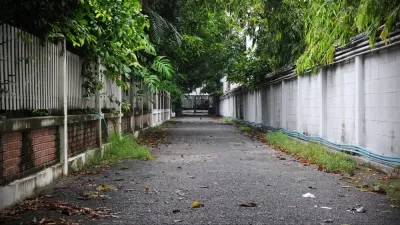Philadelphia's recent growth is noteworthy. A series of public choices and commitments have helped to restore confidence in the city's government, re-position the city's employment base, and improve quality of life for citizens.

The second half of the 20th century was largely characterized by an exodus out of the great cities of the industrial age, and the consequent growth of the suburbs. Philadelphia saw its population decline from 2.1 million in 1950 to 1.6 million in 1990, with accompanying declines in its economic base, public safety, and the fabric of many of its traditional neighborhoods. Despite widespread predictions about the continuation of this state of affairs, Philadelphia has joined many cities in reversing this trend. Still, while Philadelphia’s recent growth is noteworthy, this progress was in no way inevitable. Instead, a series of public choices and commitments have helped to restore confidence in the City’s government, re-position the City’s employment base, and improve quality of life for citizens. Together, these improvements have allowed Philadelphia to compete as a location of choice for residents, as evidenced by eight consecutive years of population growth.
Evolution of a City: Philadelphia’s Triumphs
How did Philadelphia turn around the downward spiral of the 1990s? A series of public policy decisions buttressed by strong local leadership guided the city from the brink of bankruptcy into what is today a thriving, growing metropolis. Mayor Edward Rendell’s administration in the early 1990s instituted reforms to spending, union contracts, and tax policies, which allowed Philadelphia to emerge from near bankruptcy. Rendell also spearheaded a downtown redevelopment strategy built around arts and culture, hospitality, and a “clean and safe” downtown business district.[ i]
The administration of Mayor John Street, from 2000 to 2008, built on the momentum of the Rendell years, and was aided by a ten-year tax abatement on improvements to real estate, as well as the work of the Center City District, a private sector business improvement district. The Street administration distributed public investment more broadly through the Neighborhood Transformation Initiative (NTI), a program that spent nearly $300 million to encourage clean and safe neighborhoods and to create housing opportunities.
Current Philadelphia Mayor Michael Nutter, in office since 2008, has helped to bring about city-wide growth through improvements in public safety, educational outcomes, pension funding, continued investment in place-making, and a quality-of-life strategy focused on green infrastructure and amenities. In addition, the City has made great strides on transparency and ethics, inclusivity through executive and legislative action on issues like immigrant and LGBT rights, and key transit concerns.
Philadelphia’s quality-of-life improvements have dovetailed with broader societal trends driving renewed interest in cities. Younger workers in particular have shifted away from the car-driven suburban lifestyles of their parents, leading to a repopulation of urban cores and public transit dependent lifestyles. This so-called “demographic inversion” away from the suburbs has been borne out in Philadelphia where the extended downtown core grew 16% between 2000 and 2014.[ii] Philadelphia now represents one of the largest residential downtowns in the country; the majority of these residents walk or take public transit to work, and a growing number take advantage of the City’s growing bike infrastructure.[iii]
Taking Stock of Philadelphia’s Challenges
Despite this progress, large, structural challenges remain for the City. Notable among these are entrenched poverty, public education, and municipal pension obligations. Many of these issues do not lend themselves to incremental solutions, nor are they likely to simply disappear based on the urbanist trends described above. Instead, the City’s major policy challenges, listed below, will require political will and concerted action on the part of the City and other actors.
- Poverty: Despite a relatively successful weathering and recovery from the great recession, Philadelphia’s poverty rate remains 26%, the highest among the ten biggest cities in the country, and representing about 400,000 Philadelphians.[iv] The City has made strides with its Shared Prosperity agenda, a strategy aimed at fighting poverty in the city. The City must continue to implement and fund its Shared Prosperity strategy; in addition, growing the employment base within the City in a meaningful way is a key step to addressing poverty issues.
- Public Education: Improving the City’s public education system is essential to breaking the cyclical grip of poverty. Philadelphia must establish a consistent and adequate funding level, and must address student achievement, which lags behind state averages.
- Public Safety: Safety has long been an issue of central concern in Philadelphia, with violence affecting the lives of many residents and impeding economic development in many areas.[v]
- Affordable Housing: As Philadelphia’s population has grown and certain neighborhoods have become increasingly desirable, the provision of affordable housing for the City’s residents has become an increasing challenge. As housing prices respond to market conditions in improving neighborhoods, policies must be in place to enable existing residents to capture benefits from that value and minimize displacement where possible.
- Municipal Pension Obligations: Despite an upgrade in the City’s general obligation ratings, from a fiscal standpoint the dominant concern on the City’s balance sheet remains an unfunded pension obligation of more than $5 billion (with current assets representing only 46% of total obligations).[vi] The City has enacted reforms to encourage new hires to enroll in a defined contribution plan to reduce future City liabilities, but the city must do better to encourage public employees to exercise this option, and the City should explore other policies to reduce the existing obligation.
Opportunities
Despite Philadelphia’s challenges, the City has the ability to compete as a residential location of choice. Continued progress requires leaders and residents to set aside preconceived notions about the City’s limitations, and instead adopt a bold vision of future possibilities. Major opportunities for progress include:
- Waterfront Development: The Delaware and Schuylkill Rivers remain underutilized resources for the City. Burying I-95 below ground and thus removing the significant physical and psychological barrier between the City’s downtown and the Delaware waterfront remains a substantial opportunity. Likewise, redevelopment of the Lower Schuylkill, including additional connections to the trail-ways that have already proven popular along other portions of the river offer significant opportunities.
- Tax Reform: Numerous high profile analyses have identified Philadelphia’s tax structure as a major impediment to economic growth, and successive administrations have embraced this concept yet implemented only incremental changes. Philadelphia has the opportunity, through a number of proposals that have been advanced into the public dialogue, to alter its tax structure in a way that improves the incentives for profitable firms to locate and stay in the City, without suffering adverse revenue effects or shifting the burden to the City’s residents.
- Innovation and Higher Ed linkages: One of Philadelphia’s historic strengths has been the concentration of higher education institutions in the city and region. Recent research has demonstrated that strength in the innovation economy is driven not only by the talent of individual researchers and entrepreneurs but by the ecosystem in which they operate, including economic, physical and networking assets. Philadelphia and its anchor universities having increasingly realized the importance of public and private sector linkages around knowledge creation, which can reflect across a variety of growing industries (energy, IT, medicine, etc.). The new Pennovation Center, which mixes university research with entrepreneurs in the same physical space, is an illustration of the City’s potential in this area.
After decades of dwindling population, Philadelphia has proven itself to be a city capable of progress and growth. The City’s visionary leaders, in both the public and private spheres, have helped to shape the thriving Philadelphia that exists today. But there is much work to be done. Moving forward, Philadelphia’s leaders must take stock of the City’s considerable challenges and build upon its significant strengths. With strong leadership in coming years, Philadelphia has the potential to enter into a new and exciting era of inclusive, sustainable, urban growth.
Read the full policy brief, “Philadelphia’s Triumphs, Challenges and Opportunities” here.
Ethan Conner-Ross is a Director at Econsult Solutions, Inc. (ESI) where he leads projects on economic development and public policy. Dr. Richard Voith is a Penn IUR Faculty Fellow and the President and Principal of Econsult Solutions, Inc. Susan Wachter is Co-Director of Penn IUR and Albert Sussman Professor of Real Estate, Professor of Finance, The Wharton School.
FULL STORY: Philadelphia’s Triumphs, Challenges and Opportunities

Alabama: Trump Terminates Settlements for Black Communities Harmed By Raw Sewage
Trump deemed the landmark civil rights agreement “illegal DEI and environmental justice policy.”

Planetizen Federal Action Tracker
A weekly monitor of how Trump’s orders and actions are impacting planners and planning in America.

The 120 Year Old Tiny Home Villages That Sheltered San Francisco’s Earthquake Refugees
More than a century ago, San Francisco mobilized to house thousands of residents displaced by the 1906 earthquake. Could their strategy offer a model for the present?

In Both Crashes and Crime, Public Transportation is Far Safer than Driving
Contrary to popular assumptions, public transportation has far lower crash and crime rates than automobile travel. For safer communities, improve and encourage transit travel.

Report: Zoning Reforms Should Complement Nashville’s Ambitious Transit Plan
Without reform, restrictive zoning codes will limit the impact of the city’s planned transit expansion and could exclude some of the residents who depend on transit the most.

Judge Orders Release of Frozen IRA, IIJA Funding
The decision is a victory for environmental groups who charged that freezing funds for critical infrastructure and disaster response programs caused “real and irreparable harm” to communities.
Urban Design for Planners 1: Software Tools
This six-course series explores essential urban design concepts using open source software and equips planners with the tools they need to participate fully in the urban design process.
Planning for Universal Design
Learn the tools for implementing Universal Design in planning regulations.
Clanton & Associates, Inc.
Jessamine County Fiscal Court
Institute for Housing and Urban Development Studies (IHS)
City of Grandview
Harvard GSD Executive Education
Toledo-Lucas County Plan Commissions
Salt Lake City
NYU Wagner Graduate School of Public Service



























